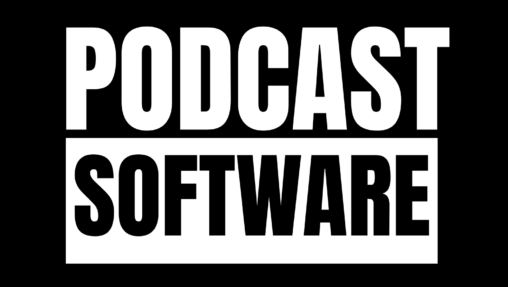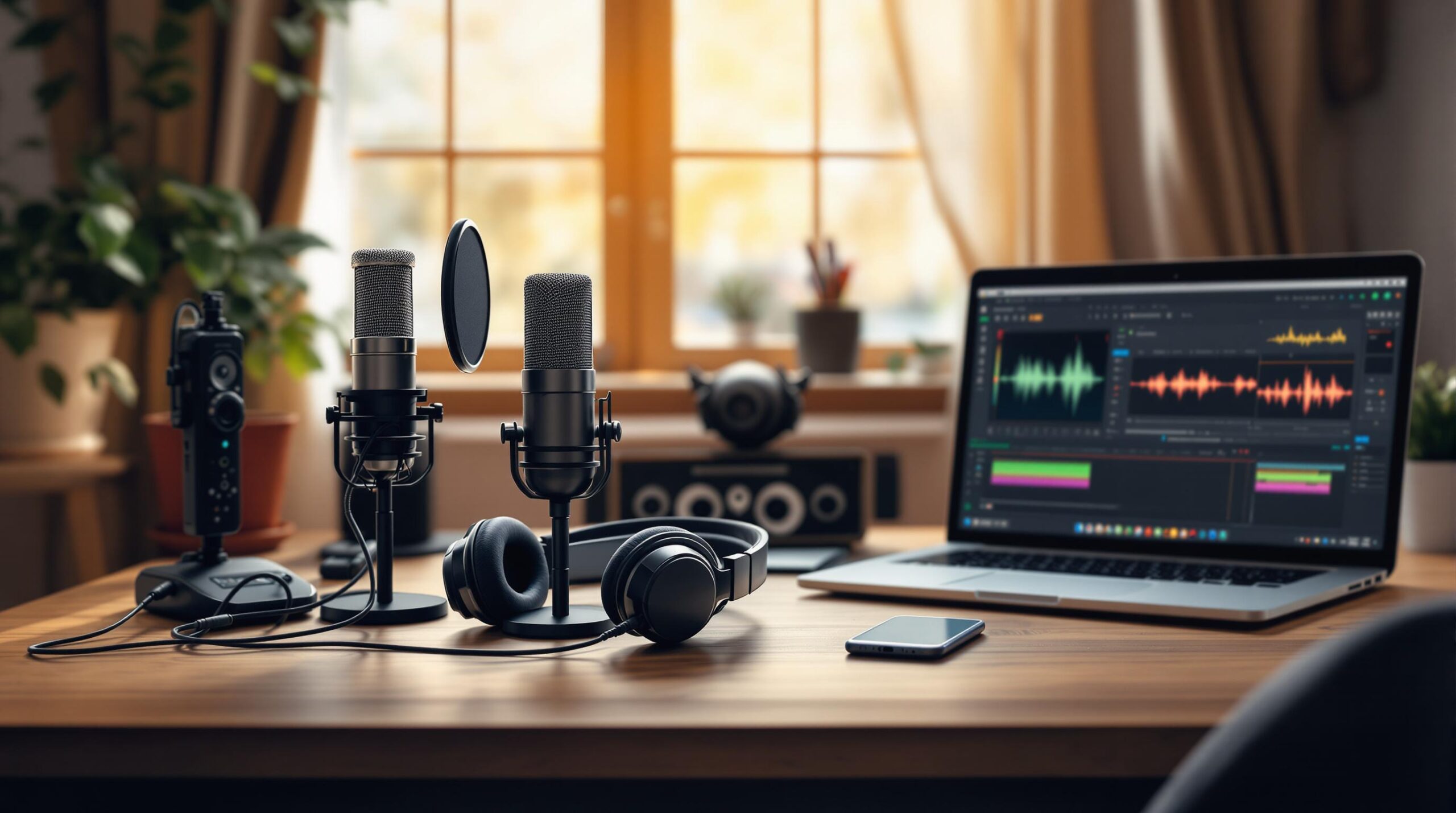Want professional-sounding audio for your podcast? Here’s exactly what you need to get started:
- Microphone: Start with a USB option like the Samson Q2U ($70) for simplicity, or upgrade to an XLR mic like the Audio-Technica AT2020 ($170) for better sound quality (requires an audio interface).
- Headphones: Use Sony MDR-7506 for accurate sound monitoring.
- Audio Interface: For XLR setups, the Focusrite Scarlett Solo ($110) is a reliable choice.
- Additional Tools: A mic stand (e.g., Neewer Boom Arm, $35) and pop filter ($20) improve recording quality.
- Acoustic Treatment: Foam panels (e.g., Auralex Studiofoam Wedges, $65) reduce echoes and reverb.
- Recording Software: Free tools like Audacity offer everything you need to record and edit.
Quick Tip: Position your mic 6–8 inches away, use live monitoring, and keep recording levels between -12dB and -6dB for the best results. Start basic, then upgrade as your podcast grows.
Best Podcast Setups for Beginners
Core Podcast Equipment
Here’s a breakdown of the gear you’ll need to kick off your podcasting journey.
Microphones
The microphone is the centerpiece of any podcasting setup. You’ll generally choose between two types:
- USB Microphones: Easy to use and perfect for beginners. The Samson Q2U, priced at about $70, offers clear sound and simple plug-and-play functionality.
- XLR Microphones: These are a step up, ideal if you plan to expand your setup later. The Audio-Technica AT2020 ($170) provides excellent sound quality. Keep in mind, XLR microphones require an audio interface, but they give you more flexibility for future upgrades.
Headphones
A good pair of headphones is essential for monitoring your audio during recording. The Sony MDR-7506 is a reliable choice, known for its accurate sound, noise isolation, and comfort during long sessions.
Audio Interfaces
For those using an XLR microphone, an audio interface is a must. The Focusrite Scarlett Solo ($110) is a great entry-level option. It offers clean sound, simple controls, and a sturdy USB-C connection for consistent performance.
Once you’ve got these basics covered, you can start looking into additional gear to take your podcast to the next level.
sbb-itb-9f49a8d
Additional Tools for Beginners
While essential gear like microphones and headphones are a must, adding a few extra tools can take your audio quality to the next level.
Mic Stands and Pop Filters
A reliable mic stand, such as the Neewer Boom Arm ($35), keeps your microphone steady and includes cable management features. It also comes with a sturdy C-clamp for easy desk mounting. To minimize plosive sounds (those harsh "P" and "B" sounds), consider a pop filter like the Auphonix Pop Filter ($20). This small addition can make your recordings sound much clearer.
Acoustic Treatment
After securing your mic, it’s time to improve the sound quality of your recording space. Acoustic treatment can help reduce unwanted echoes and reverb. Products like the Auralex Acoustics Studiofoam Wedges ($65 per pack) are a great starting point. Use 2-inch foam panels behind your mic, bass traps in room corners, and 1-inch foam panels on the side walls to create a cleaner sound environment.
Recording Software
For recording and editing, Audacity is a popular free option that offers features like:
- Multi-track recording
- Built-in noise reduction
- Compatibility with various audio formats
- Basic editing tools
If you’re looking for something more user-friendly with automation, Alitu ($32/month) is a great alternative. It simplifies editing and handles processing for you.
"Investing in a good microphone and using appropriate recording software can significantly enhance audio quality. For beginners, free tools like Audacity offer professional-grade features that rival paid alternatives." [1][2]
Setting Up Your Podcast Space
Once you’ve got your equipment sorted, it’s time to focus on creating a recording space that ensures clear, professional-quality audio.
Optimizing Your Podcast Space
Choose equipment that suits your podcast style and potential future needs. For instance, USB microphones are great for ease of use, while XLR setups offer more flexibility as you grow. Your recording environment is just as important – dedicating even a quiet corner of a room can make a big difference in sound quality. Start with the basics and upgrade as your needs evolve.
Place your microphone about 6–8 inches from your mouth and slightly off-center to reduce breath sounds and plosives [1]. To improve sound quality, consider acoustic treatment: install 2-inch foam panels behind the mic, 1-inch panels on the side walls, and bass traps in the corners to minimize echoes and reverb.
Recording Techniques
Live monitoring is key to achieving polished audio. Keep your recording levels between -12dB and -6dB, maintain a consistent distance from the mic, and use closed-back headphones to catch any issues during recording. Regularly check your equipment to ensure everything is working as it should [2].
"Using headphones for live monitoring while recording is essential for catching audio issues before they become problems in post-production. Combined with proper microphone technique, this approach can save hours of editing time." [1][2]
Conclusion
You don’t need a massive budget to start a podcast. With gear like the Samson Q2U USB microphone or the Audio-Technica AT2020 XLR microphone paired with a Focusrite Scarlett Solo interface, you can achieve excellent sound without overspending. Prioritize the essentials: a good microphone, dependable headphones, and free recording software like Audacity. Often, small tweaks – like improving your microphone technique or adding basic acoustic treatment – can do more for your audio quality than expensive equipment.
As your podcast develops, you can gradually upgrade your setup. Consider adding higher-end microphones or enhancing your acoustic treatment as your needs evolve. Start with simple, beginner-friendly gear that allows you to focus on producing engaging content with great sound. Now that you’re equipped with the basics, it’s time to hit record and start creating! Let your content shine while your equipment evolves alongside your podcast.

